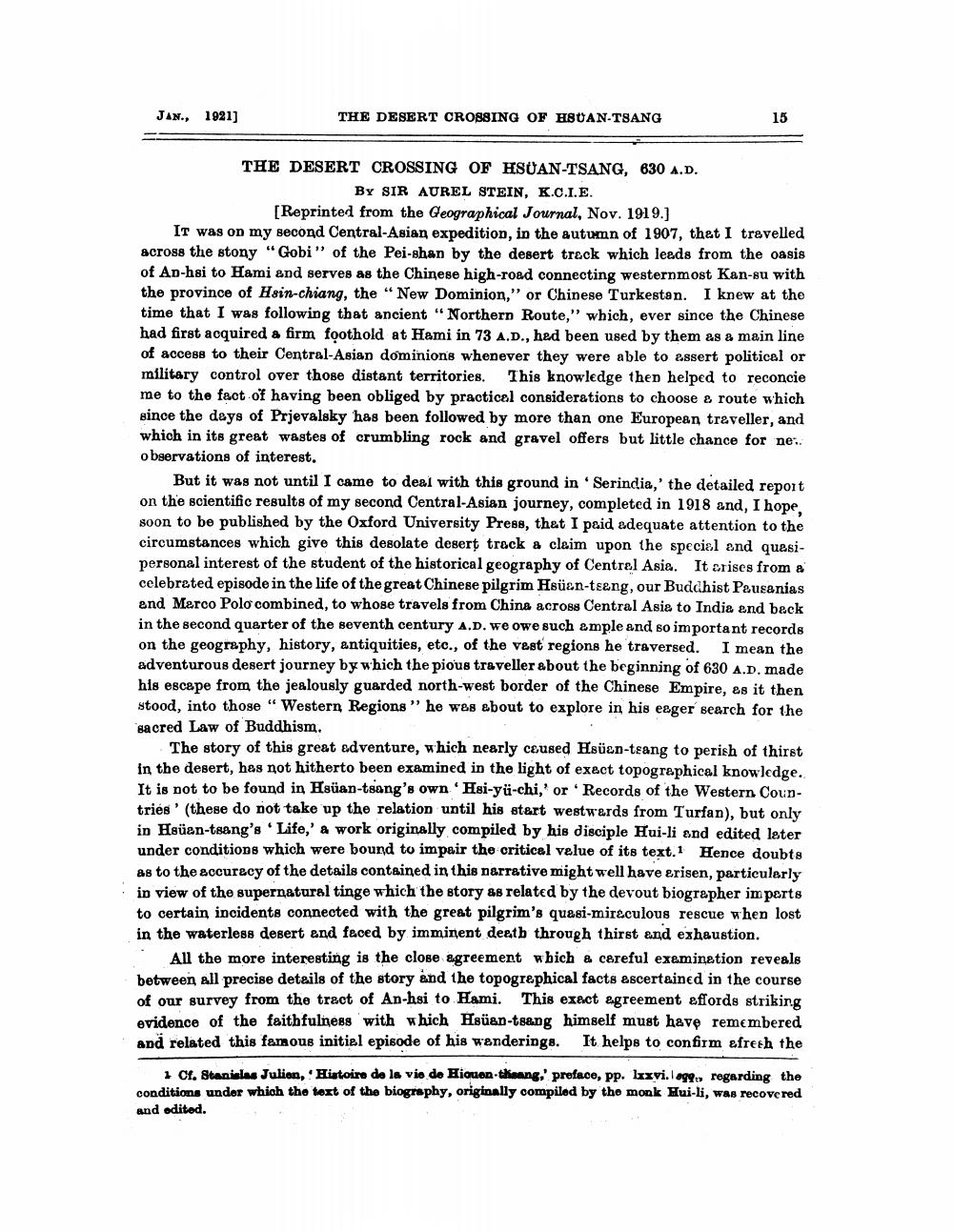________________
JAN.,
1921)
THE DESERT CROSSING OF HSUAN-TSANG
THE DESERT CROSSING OF HSUAN-TSANG, 630 A.D.
BY SIR AUREL STEIN, K.C.I.E.
[Reprinted from the Geographical Journal, Nov. 1919.) It was on my second Central Asian expedition, in the autumn of 1907, that I travelled across the stony "Gobi" of the Pei-shan by the desert track which leads from the oasis of Ad-hsi to Hami and serves as the Chinese high-road connecting westernmost Kan-su with the province of Hsin-chiang, the “New Dominion," or Chinese Turkestan. I knew at the time that I was following that ancient "Northern Route," which, ever since the Chinese had first acquired a firm foothold at Hami in 73 A.D., had been used by them as & main line of access to their Central-Asian dominions whenever they were able to assert political or military control over those distant territories. This knowledge then helped to reconcie me to the fact of having been obliged by practical considerations to choose a route which since the days of Prjevalsky has been followed by more than one European traveller, and which in its great wastes of crumbling rock and gravel offers but little chance for ne.. observations of interest.
But it was not until I came to deal with this ground in 'Serindia,' the detailed report on the scientific results of my second Central-Asian journey, completed in 1918 and, I hope soon to be published by the Oxford University Press, that I paid adequate attention to the circumstances which give this desolate desert truck a claim upon the special and quasipersonal interest of the student of the historical geography of Central Asia. It crises from a celebrated episode in the life of the great Chinese pilgrim Hsüen-teeng, our Buddhist Pausanias end Merco Polo combined, to whose travels from China across Central Asis to India and back in the second quarter of the seventh century A.D. we owe such ample and so important records on the geography, history, antiquities, etc., of the vest regions he traversed. I mean the adventurous desert journey by which the pious traveller about the beginning of 630 A.D. made his escape from the jealously guarded north-west border of the Chinese Empire, as it then stood, into those "Western Regions" he was about to explore in his eager search for the sacred Law of Buddhism.
The story of this great adventure, which nearly caused Hsüen-teang to perish of thirst in the desert, has not hitherto been examined in the light of exact topographical knowledge. It is not to be found in Hsüan-tsang's own Hsi-yü-chi,' or 'Records of the Western Countries' (these do not take up the relation until his start westwards from Turfan), but only in Hsüan-tsang's 'Life,' a work originally compiled by his disciple Hui-li end edited later under conditions which were bound to impair the critical value of its text. Hence doubts as to the accuracy of the details contained in this narrative might well have erisen, particularly in view of the supernatural tinge which the story 88 related by the devout biographer im perts to certain incidents connected with the great pilgrim's quasi-mireculous rescue when lost in the waterless desert and faced by imminent death through thirst and exhaustion.
All the more interesting is the close agreement which a careful examination reveals between all precise details of the story and the topographical facts ascertained in the course of our survey from the tract of An-hsi to Hami. This exact agreement effords striking evidence of the faithfulness with which Hsüan-tsang himself must have remembered and related this famous initial episode of his wanderings. It helps to confirm efresh the
1 Cf. Stanialas Julion, Histoire de la vis de Hiquen-thoang,' preface, pp. lxxvi. 99. regarding the conditions under which the text of the biography, originally compiled by the monk Hui-li, was recovered and edited.




